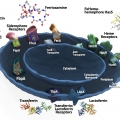Nearly all bacteria require iron to grow. Many bacteria growing aerobically in iron-starved environments produce siderophores, small MW chelating ligands that coordinate Fe(III) and facilitate iron uptake into the bacterium. The largest class of new siderophores are acylated, which confer new dynamics in the iron-uptake process. We are investigating the biosynthesis, tailoring, membrane partitioning and biological function of this class of amphiphilic siderophores.




